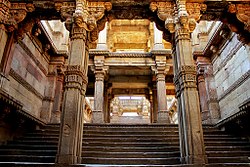| This article needs additional citations for verification. Please help improve this article by adding citations to reliable sources. Unsourced material may be challenged and removed. Find sources: "Dada Harir Stepwell" – news · newspapers · books · scholar · JSTOR (February 2014) (Learn how and when to remove this message) |
| Bai Harir Stepwell | |
|---|---|
 Stepwell staircase Stepwell staircase | |
| General information | |
| Town or city | Ahmedabad |
| Country | India |
| Coordinates | 23°02′25″N 72°36′19″E / 23.0402692°N 72.605416°E / 23.0402692; 72.605416 |
| Elevation | 72.6662992 m |
| Construction started | 1499 |
| Completed | 15th century |
| Technical details | |
| Floor count | Five storied stepwell |
| Design and construction | |
| Architect(s) | Local |
| Designations | Monument of National Importance ASI Monument No. N-GJ-18 |
Bai Harir Sultani Stepwell is a 15th century stepwell in Asarwa area 15 km off Ahmedabad, Gujarat, India.
History


The stepwell was built in 1485 by Dhai Harir, a household lady of Mahmud Begada according to the Persian inscription in the stepwell. She was the superintendent of the royal harem.
Dhai Harir built a mosque and a tomb in which she was buried. The well bears two inscriptions, one in Sanskrit on the south, and one in Arabic on the north wall, of the first gallery.
The Arabic writing reads:
This holy and wholesome water; the splendid travellers' rest-house enclosed on four sides by carved and painted walls, and a grove of fruit trees with their fruit, a well, and a pool of water for the use of man and heist, were built in the reign of the Sultan of the Sultans of the age, established by the grace of God and of the faith, Abul Fath Mahmud Shah, son of Muhammad Shah, son of Ahmed Shah, son of Muhammad Shah, son of Muzaffar Shah the Sultan, may God keep his kingdom. Dated the metropolis of the kingdom the 2nd of Jamadi-ul-awwal in the 26th year of the reign.
A Sanskrit inscription says that the step-well was built in December 1499 AD. It was during the reign of Mahmud Shah that Bai Harir Sultani, locally known as Dhai Harir, built the step-well. The name later corrupted into Dada Hari. It costed 3,29,000 Mahmudis (₹ 3 lakh) at that time. The ornate step-well has spiral staircases pieced into the sidewall of the well shaft and descending to the different platform levels.
Structure

Built in sandstone in Solanki architectural style, the Dada Harir stepwell is five stories deep. The well is designed in five levels, the east level being octagonal in shape. Each level is provided with finely sculptured pillars and volute capitals. The niches are full of finely sculptured stone work and parapets of kumbha or geometric friezes. The builder has also provided stone ledges for people to take rest. Each stair also contains a square domed kiosk with an overhanging chajja (cover of a roof). The pillars and platforms rise vertically one on top of the other. The steps are open to the sky, whereas the kutas (landings) are closed with stone slabs. The well shaft is circular. There are passage ways at all levels which connect the shaft to the octagonal space above the tank. The shaft wall is covered with geometric designs. From the first story level, three staircases lead to the bottom water level of the well, which is considered a unique feature.

At the level of the ground, it is 190 feet long by forty wide. At the east end, from a domed canopy, a descent of eight steps leads to a covered gallery. A second flight of nine steps leads to another gallery, and a third of eight steps to the lowest gallery two or three foot above the level of the water. At each landing a corridor runs along the sides and leads to other galleries that cross the well at intervals.
Built along an east–west axis, entrance is from the East, the two spiral staircases are in West, near the well. The structural system is typically Indian style with traditional trabeate with horizontal beams and lintels. At the bottom of the well is a square stepped floor in the shape of a funnel extending to the lowest plane. This is chiseled into a circular well. Above the square floor, columns, beams, wall and arched openings spiral around; a feature that continues to the top. The top part of the well, however, is a vertical space open to the sky. The four corners of the square are strengthened with stone beams, set at 45 degrees angle. The motifs of flowers and graphics of Islamic architecture blend very well. The dominant carvings on the upper floors are of elephants (3 inches (76 mm) in size, each of a different design).
Gallery
See also
References
- ^ Gazetteer of the Bombay Presidency: Ahmedabad. Government Central Press. 1879. p. 282.
- Hultzsch, E.; Abbot, J. E. (1912). "Bai Harir's Inscription at Ahmadabad, AD 1499". Epigraphia Indica. Vol. IV. pp. 297–300.
- Rajan, Soundara (27 November 2009). "Bad times for Dada Hari ni Vav in Gujarat". Retrieved 14 December 2014.
- M. Amirthalingam, ed. (19 August 2023). ECOLOGICAL TRADITIONS OF INDIA. C.P.R. Environmental Education Centre. ISBN 978-81-86901-25-0.
External links
- Dada Harir Vav
- Ranked #19 out of 121 things to do in Ahmedabad
- Dada Harir Stepwell on Gujarat Tourism Official Website
- Bad times for Dada Hari ni Vav in Gujarat



